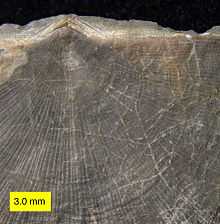Ctenostomata
From Wikipedia, the free encyclopedia
| Ctenostomata | |
|---|---|
| Scientific classification | |
| Kingdom: | Animalia |
| Phylum: | Bryozoa |
| Class: | Gymnolaemata |
| Order: | Ctenostomata |
| Suborders | |
| |
The Ctenostomata are an order of bryozoans in the class Gymnolaemata. The great majority of ctenostome species are marine, although Paludicella inhabits freshwater.

Ropalonaria venosa, an etching trace fossil of a Late Ordovician ctenostome bryozoan on a strophomenid brachiopod valve; Cincinnatian of southeastern Indiana.[1]
They are distinguished from their close relatives, the cheilostomes, by their lack of a calcified exoskeleton. Instead, the exoskeleton is chitinous, gelatinous, or composed only of a soft membrane, and always lacks an operculum. Colonies of ctenostomes are often composed of elongated, branch-like stolons, although more compact forms also exist.
References
Barnes, Robert D. (1982). Invertebrate Zoology. Philadelphia, PA: Holt-Saunders International. p. 910. ISBN 0-03-056747-5.
This article is issued from Wikipedia. The text is available under the Creative Commons Attribution/Share Alike; additional terms may apply for the media files.